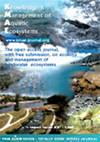波兰南部两个生态区河流非生物类型植被的人为变化影响
IF 1.7
3区 环境科学与生态学
Q3 FISHERIES
引用次数: 11
摘要
由于人类活动,全世界河流的水质正在下降。气候变化和人口增长可能加剧这一现象。我们假设水的物理和化学参数是解释河流中大型植物分布的最重要特征,它们反映了潜在地质和人为转化的差异。在本研究中,我们分析了人为转化对波兰南部维斯瓦河和奥得河流域8条河流中大型植物结构的影响。典型对应分析结果表明,传导性、海拔、水文形态多样性指数(WRH)所反映的河流自然特征和邻近土地利用,以及中沙是影响大型植物分布的最重要因素。包括外来入侵种在内的泛栖种与WRH指数呈负相关,与高导电性呈正相关。电导率的增加导致植被多样性的丧失,并导致淡水物种被半咸淡水或耐盐物种所取代。与盐度为0.45-0.64 PSU相比,盐度为2.96-5.16 PSU使河流中大型植物类群数量减少30%以上。由于很少有研究调查盐度对大型植物的影响,因此需要进一步的研究来解释这一现象。因此,我们建议在研究大型植物在河流中的分布时广泛使用水文形态学指标。本文章由计算机程序翻译,如有差异,请以英文原文为准。
Impact of anthropogenic transformations on the vegetation of selected abiotic types of rivers in two ecoregions (Southern Poland)
The quality of water in rivers is declining worldwide due to anthropogenic activities. This phenomenon may be exacerbated by climate change and population growth. We hypothesised that both physical and chemical parameters of water, which reflect the differences in the underlying geology and anthropogenic transformations, are the most important characteristics to explain the distribution of macrophytes in rivers. In the present study, we analysed the effect of anthropogenic transformation on the structure of macrophytes in eight rivers within the river basins of the Vistula and Oder Rivers (Southern Poland). A canonical correspondence analysis showed that conductivity, altitude, natural features of rivers and adjacent land use, which are indicated by the values of the Hydromorphological Diversity Index (WRH), and medium sand were the most important factors that affected the distribution of macrophytes. The eurytopic species, including invasive alien species, were negatively correlated with the WRH index and positively correlated with high conductivity. An increase in the conductivity led to a loss of vegetation diversity and caused the replacement of freshwater species with brackish or salt-resistant species. Salinity of 2.96–5.16 PSU decreased the number of macrophyte taxa by over 30% in the rivers as compared to salinity of 0.45–0.64 PSU. Because very few studies have investigated the effect of salinity on macrophytes, further research is needed to explain this phenomenon. We therefore suggest extensive use of hydromorphological indices in studies on the distribution of macrophytes in rivers.
求助全文
通过发布文献求助,成功后即可免费获取论文全文。
去求助
来源期刊

Knowledge and Management of Aquatic Ecosystems
环境科学-海洋与淡水生物学
CiteScore
3.70
自引率
5.60%
发文量
22
审稿时长
>12 weeks
期刊介绍:
Knowledge and Management of Aquatic Ecosystems (KMAE-Bulletin Français de la Pêche et de la Pisciculture since 1928) serves as a foundation for scientific advice across the broad spectrum of management and conservation issues related to freshwater ecosystems.
The journal publishes articles, short communications, reviews, comments and replies that contribute to a scientific understanding of freshwater ecosystems and the impact of human activities upon these systems. Its scope includes economic, social, and public administration studies, in so far as they are directly concerned with the management of freshwater ecosystems (e.g. European Water Framework Directive, USA Clean Water Act, Canadian Water Quality Guidelines, …) and prove of general interest to freshwater specialists. Papers on insular freshwater ecosystems and on transitional waters are welcome. KMAE is not a preferred journal for taxonomical, physiological, biological, toxicological studies, unless a clear link to ecological aspects can be established. Articles with a very descriptive content can be accepted if they are part of a broader ecological context.
 求助内容:
求助内容: 应助结果提醒方式:
应助结果提醒方式:


